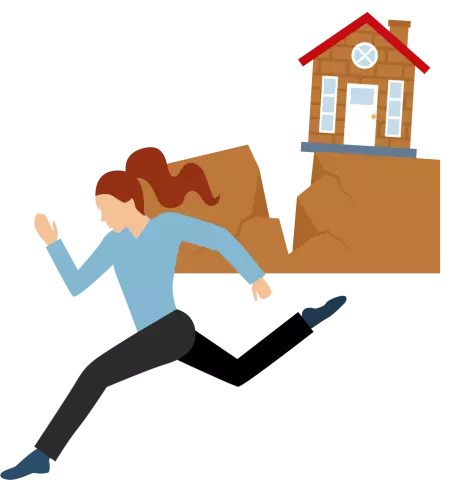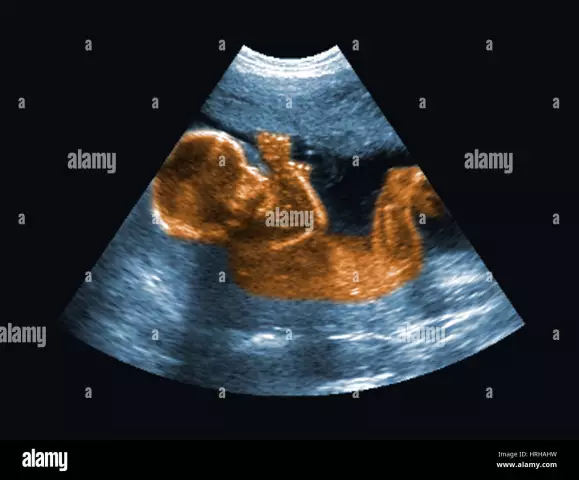- Author Rachel Wainwright [email protected].
- Public 2023-12-15 07:39.
- Last modified 2025-11-02 20:14.
Code of Conduct for Natural Disasters
Summer has come. People look forward to the joys of vacation, dreaming of a good rest, seeing new places and getting fresh impressions. However, the wonderful summer time brings us not only positive emotions. It is at this time that the risk of falling into a dangerous situation associated with natural disasters significantly increases.
Of course, faced with this kind of trouble, we count on the rescue services. Unfortunately, employees of such organizations are not always able to quickly reach all victims. That is why, once in a natural disaster zone, it is important to act in such a way as to minimize risks and be able to wait for qualified assistance.
Let's talk about the rules of behavior during natural disasters.
Hurricane
Usually, meteorologists warn about the possibility of a squally increase in the wind for several hours. It is extremely unwise to ignore these messages. Having learned about the approach of a hurricane, it is advisable to cancel all cases related to leaving the house. If this is not possible and a flurry found you on a city street, try not to approach trees, advertising structures, bridges, power lines and light buildings (market stalls, fences, pavilions of ground transport stops, etc.). It is their wind that will destroy them in the first place, and you can be injured by flying debris. Find a shelter urgently: any capital structure, underpass, metro station will do.
It may happen that there is no safe cover nearby. In such a situation, you should remain in place or slowly move towards the capital buildings, covering your head with any durable object (a sheet of plastic, plywood or cardboard). If you hit a hurricane in the field or on a country road, you need to go to the highway: there you will be helped faster.
If the disaster caught you in the car, you can wait out the hurricane inside, but you must stop the car in a place where flying debris of light buildings and street structures will not fall on it.
When you are indoors during a hurricane, stay away from windows. It is best to take refuge in rooms located at the back of the apartment. Turn off all electrical appliances, turn off the gas valve. Keep the radio turned on to hear emergency messages in time.

Source: depositphotos.com
Natural fire
A forest fire is especially dangerous if the fire occurs in dry weather and strong winds. In no case should you stay close to the source of disaster. In such a situation, it is necessary to urgently move towards any open space (roads, fields, etc.) or a natural reservoir. If the fire is moving quickly, it is best to enter a river or lake and try to ride out the disaster by covering your head and face with a damp cloth.
It is equally dangerous to be near peat bogs located in forest fire zones. In these places, deep, but imperceptible from above, funnels are often formed, inside of which peat burning continues even several months after the top fire has already been extinguished. In order not to fall into the trap, it is better to refuse to visit such natural sites altogether.

Source: depositphotos.com
Drought
There are regions for whose inhabitants a dry summer is quite common. However, weather anomalies do occur when protracted anticyclones create long-term high temperatures with no rain in the middle lane.
If you have to stay in the city in hot weather, try not to leave the premises in the middle of the day. Wear clothing made from natural fibers (cotton, linen, fine silk). Don't go outside without a hat and sunglasses. Apply UV-protective cosmetics to your face and exposed parts of the body regularly. Always have a container of clean water with you; drink often but little by little. Cool the air in residential and industrial premises by spraying with cold water; do not open the windows until nightfall.
In the heat, you should not get carried away with fatty, sweet and spicy dishes, as well as smoked meats, canned food and fast food. It is better to give preference to fruits, berries, vegetables and fermented milk products. You can not drink alcohol: it increases the load on the heart and blood vessels. For drinking, clean water or mineral waters without gas are suitable; most other drinks only increase thirst.
Residents of rural areas in drought risk facing water shortages. To prevent this from happening, you should fill the existing containers with water in advance. It is important to remember that such drinking water can only be consumed after boiling. This rule also applies to liquid taken from natural reservoirs: in any case, it needs multi-stage purification.

Source: depositphotos.com
Storm
You can only suffer from a lightning strike if the thunderstorm front is directly above you. The location and movement of the front is determined by the time interval between the flash of lightning and the following thunderclap. If it is more than 3 seconds, then the thunderstorm is located at a distance of about one kilometer from you and does not pose immediate danger.
Being in a city apartment, it is almost impossible to get hit by lightning, but nevertheless, in a severe thunderstorm, it is worth disconnecting electrical appliances and chargers from the network and not touching grounded metal objects (water and gas pipes, central heating batteries, etc.). Inhabitants of a village house tend to take more risks. They need to close stove dampers, turn off external antennas, temporarily refuse landline phone calls, and stay away from windows.
If a thunderstorm finds you outside your home, remember not to do the following:
- hide under fragile shelters (awnings, cloth tents, beach umbrellas, etc.);
- hide under freestanding trees;
- enter the water;
- pick up long objects (fishing rod, cane, umbrella);
- lie down on the ground or stand in an open place;
- be near metal objects (boat, motorcycle, bicycle);
- touch structures made of metal (fences, power transmission line supports, etc.).
In a thunderstorm in nature, it is safest to be in the midst of a low bush. In a field or meadow, when a thunderstorm front is approaching, you need to go down into a ravine or ditch and squat down, clasping your knees with your hands. You can wait out the elements in a car or trailer with a flat roof by closing the windows and not touching the metal parts of the body.

Source: depositphotos.com
Flood
Floods are rarely completely unexpected. Usually, a warning about the risk of flooding an area comes several days before a disaster occurs. In this case, the most correct thing is to immediately go to the places recommended by the personnel of the rescue services.
If you did not have time or could not leave the flooded area in time, do not try to get out of it on your own unless absolutely necessary: for an inexperienced person, such actions can end sadly. Experts recommend waiting for help by sitting on any non-flooded area of land, a roof of a building or a large tree and giving distress signals (it is best to hang out a piece of light-colored cloth during the day and use a flashlight at night).

Source: depositphotos.com
Landslide
In some regions, the likelihood of landslides is constant. If you find yourself in such an area, remember the following:
- the approach of a landslide can be seen from the state of the details of the buildings. In particular, there is jamming of windows and doors, distortion of door and window frames, the appearance of vertical cracks on the walls, water leakage in basements;
- even with a slight displacement of the soil (several centimeters per month), the risk of accidents when using electrical appliances, water supply and main gas is constantly increasing;
- if the landslide moves 50 centimeters or more per day, residents need immediate evacuation.

Source: depositphotos.com
Mud
Mudflow is an extremely dangerous natural phenomenon typical for mountainous regions. It is almost impossible to escape from the mud stream descending along the slope. Therefore, if you are going to travel in the mountains, you should take the choice of the place of the future hike very seriously, find out in advance about the anti-mudflow measures carried out there and assess the possible risks.
Before climbing the mountains, you need to familiarize yourself with the weather forecast, inform the representatives of the rescue services about your plans and, if necessary, adjust the route in accordance with their recommendations.
In case of accidental entry into the convergence zone of the mud flow, the risk can be minimized in only one way: to avoid the bottom of ravines and narrow crevasses. It is best to climb the side slope at least 50 meters, choose the safest place and wait for help.

Source: depositphotos.com
Hail
Small hail is very unpleasant, but relatively harmless. Large hailstones can cause serious injury to a person. In addition, this natural phenomenon is usually accompanied by thunderstorm activity and heavy rainfall, fraught with additional hazards.
If a strong hail overtook you in the open, try to protect your head from blows with any hard object (book, bag) and find shelter urgently. As a rule, the element rages no longer than 6-7 minutes. When moving along the street, do not step on the places where hailstones accumulate: they are very slippery, and you risk falling.
If you get hit by hail in your car, stop the car, turn your face to the center of the cabin and cover your face and head with some kind of cloth so as not to get hurt by shrapnel if pieces of ice break the glass. Do not try to continue driving or getting out of the car until the hail is over.

Source: depositphotos.com
Earthquake
People living in seismically active areas usually know how to act in case of a threat or during an earthquake, but it is vital for inexperienced tourists to familiarize themselves with these rules in advance.
When in a region with a high risk of earthquakes, you need to keep all documents, cash, a container of water, a flashlight and spare batteries with you at all times. Having felt the signs of seismic vibrations (swinging ceiling lamps, falling objects, etc.), you should:
- leave the building immediately without using the elevator;
- on the street, try to retire to an open place;
- do not return to the room until the threat of repeated shocks has passed (the first 2-3 hours after the earthquake are considered the most dangerous).
Remaining indoors, stand near an internal capital wall, in a corner or in a doorway. You can hide under the table (it will protect you from falling objects). Do not go near the windows, do not go out to the balcony. Avoid dangling electrical wires. Do not use open fire, electrical appliances or gas equipment.
If you are stuck in a blockage, save water and give distress signals constantly (shouting, banging on pipes and radiators, etc.). Try not to panic. Remember that special services do not stop activities to find survivors as long as there is even the slightest hope of their salvation.

Source: depositphotos.com
Eruption
If you intend to visit an area in which an active volcano is located, you must familiarize yourself with the forecast of its activity in advance. Eruptions are almost never accidental, and the risk of suffering from them is minimal.
When you receive a warning about a possible eruption, try to prepare. Of course, if there is a high likelihood of the release of lava masses or large stones, you should immediately evacuate, but a small release of volcanic gases and ash can be waited out indoors. To protect yourself, close the windows and doors tightly, make a supply of water and food for 3-5 days, organize autonomous sources of light and heat. Prepare gauze respirators, goggles and clothing. Stay in place and stay home until the alarm is cleared.

Source: depositphotos.com
General recommendations
When entering a natural disaster zone, it is important not to neglect the available information, trust the personnel of the rescue services and keep yourself in control. In many cases, this is enough not only not to suffer yourself, but also to provide the necessary assistance to others. Reasonable and responsible behavior will allow you to get out of dangerous situations unscathed and get extremely positive emotions from your summer vacation.
YouTube video related to the article:

Maria Kulkes Medical journalist About the author
Education: First Moscow State Medical University named after I. M. Sechenov, specialty "General Medicine".
Found a mistake in the text? Select it and press Ctrl + Enter.






